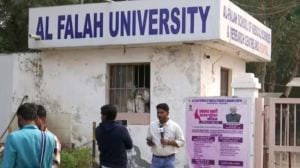Oranges in the red
Nagpur is synonymous with oranges. Visitors here go back with sweet memories of this ‘world famous’ ...

Nagpur is synonymous with oranges. Visitors here go back with sweet memories of this ‘world famous’ mandarin variety. But ask those who have been cultivating it, and their stories are laced with bitterness.
Like cotton, the orange crop has become more of a bane than boon for farmers in ‘India’s California’. The average market rate of Rs 500-1,000 fruits is likely to be around Rs 1,300-1,500 this year, experts feel.
Already, availability is down by 66 per cent. ‘‘About 50 per cent of gardens are likely to go dry,’’ says Dr P.V. Amin, agronomist and former vice chancellor of Punjabrao Krishi Vidyapeeth (PKV), a research institute. Farmers are already shifting to mousambi, a more lucrative citrus variety.
In fact, Dr Amin predicts that the July blossom will also be poor and the prices will hover around Rs 1,000-2,000. ‘‘The worst part is that the after-effects of a bad year continue for another three years,’’ he feels.
Shantanu Solav, a prominent cultivator from Warud, a prosperous town known for orange farming, adds, ‘‘The vagaries of nature have always kept cultivators on tenterhooks. This time, a severe water cruch, coupled with a pest menace, has created havoc. And there doesn’t seem any end to it. We might have to wind up orange cultivation in the near future, what with the water table dipping to around 700 ft.’’
‘‘Actually, the climatic and soil conditions here are not conducive to orange cultivation,’’ feels Dr Amin. ‘‘Vidarbha is the single biggest producer of oranges (Nagpur mandarin) with 1.4 lakh hectares under cultivation with an average yield of 8 tonnes per hectare. Compare it with the 45 tonnes per hectare in US (California, Florida), Brazil and Peru,’’ he says. ‘‘Only around 100 to 150 fruits per plant bear up to 1,000 fruits. An average of 300 per 1,000 plants blossom. The gardens may last up to an average 50 years,’’ he adds. ‘‘In contrast, the oldest surviving garden in the world in Italy is 200 years old.’’
Babasaheb Kedar, an ex-minister and a veteran orange cultivator, blames it on high production costs. ‘‘It is a popular misconception that orange cultivation reaps rich rewards,’’ says Kedar, whose group rules the Agriculture Produce Marketing Committee at Nagpur. He points out that the present variety is being grown by Vidarbha’s farmers for generations. It is easily susceptible to pest attack, he says, stressing the need for better varieties.
Kedar admits that Vidarbha farmers are not as progressive as their counterparts in western Maharashtra. ‘‘The onus is on scientists. What have they been doing all these years?’’ he asks, referring to PKV’s 30-year-old orange research farm in the district and the prestigious National Research Centre for Citrus (NRCC).
However, NRCC director Shyam Singh is quick to defend his organisation’s work. ‘‘We have developed disease-free varieties as well as techniques for preservation,’’ he says. ‘‘But we can’t artificially induce flowering. That is nature’s job.’’
Singh also debunks the claim that the Nagpur variety cannot be preserved for long.
But he admits that his institute has not been able to do much in areas of value-addition and processing and blames it on lack of research staff. ‘‘We have advertised the posts and hope to have the requisite people soon,’’ he says.
In fact, exports have been marred by lack of processing techniques. ‘‘The ACC plant closed down within one year. Similarly, the two plants started by the State govt are also in bad shape,’’ says Kedar. ‘‘The Nagpur variety is a table fruit and is not juicy. Hence is not fit for processing. For export, we must have a juicy variety, as, in the West, the craze is for juice,’’ says Kedar.
So what happens to the research which the NRCC claims to have validated through enterprises like Rashtriya Kisan Melas, transfer of technology programme for State officials and symposiums and workshops? ‘‘We have a mandate for research, while its extension has to be done by the government,’’ says Shyam Singh. ‘‘Yet, we do try to reach out to as many farmers as possible.’’The state’s agriculture department has also been giving 50 per cent of costs of insecticides and drip irrigation. We give 100 per cent finance under the Employment Guarantee Scheme. What else can we do?’’ asks Superintending Agriculture Officer of the state department, M.L. Gedam. The disease-free variety has been developed under ideal greenhouse conditions, he adds. ‘‘It’s no use to ordinary farmers. Moreover, a sapling of such a variety costs Rs 20 as against the usual Rs 5. Can an ordinary farmer afford it?’’



- 01
- 02
- 03
- 04
- 05




























